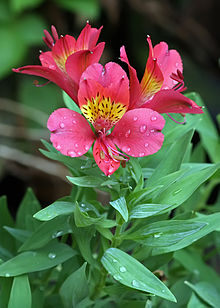
Back أليستروميريا Arabic اليستروميريا ARZ Alströmeriya Azerbaijani Alstremèria Catalan Alstroemeria CEB Alstromérie Czech Inkalilje Danish Inkalilien German Αλστραιμερία Greek Alstremerio Esperanto
| Alstroemeria | |
|---|---|

| |
| Peruvian lily (Alstroemeria aurea) | |
| Scientific classification | |
| Kingdom: | Plantae |
| Clade: | Tracheophytes |
| Clade: | Angiosperms |
| Clade: | Monocots |
| Order: | Liliales |
| Family: | Alstroemeriaceae |
| Tribe: | Alstroemerieae |
| Genus: | Alstroemeria L. |
| Type species | |
| Alstroemeria pelegrina L.[1] | |
| Synonyms[2] | |
| |


Alstroemeria (/ˌælstrɪˈmɪəriə/), commonly called the Peruvian lily or lily of the Incas, is a genus of flowering plants in the family Alstroemeriaceae. They are all native to South America, although some have become naturalized in the United States, Mexico, Australia, New Zealand, Madeira and the Canary Islands. Almost all of the species are restricted to one of two distinct centers of diversity: one in central Chile and southern Argentina, the other in eastern Brazil. Species of Alstroemeria from Patagonia are winter-growing plants, while those of Brazil are summer growing. All are long-lived perennials except A. graminea, a diminutive annual from the Atacama Desert of Chile.
- ^ Alstroemeria | International Plant Names Index. (n.d.). Retrieved August 12, 2023, from https://www.ipni.org/n/326331-2
- ^ Kew World Checklist of Selected Plant Families